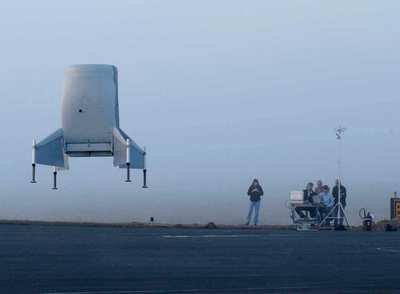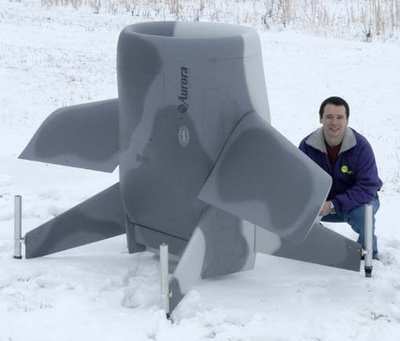Thu, Sep 11, 2003
Aurora Demonstrates Potential for a New Breed of Unmanned
Aircraft
 Aurora Flight Sciences Corporation
has announced the successful first flight of its unique
GoldenEye-100 unmanned aerial vehicle (UAV). During the early
morning hours on Monday, the barrel-shaped autonomous vehicle
executed a smooth vertical take-off and transition to a stable
hover well above the ground-hugging mist at the Manassas Regional
Airport in Virginia. "This demonstration completes a key milestone
in our development program," according to Carl Schaefer,
GoldenEye-100 Program Manager. "It confirms the robustness of
flight control systems and other key technologies in this unique
autonomous system."
Aurora Flight Sciences Corporation
has announced the successful first flight of its unique
GoldenEye-100 unmanned aerial vehicle (UAV). During the early
morning hours on Monday, the barrel-shaped autonomous vehicle
executed a smooth vertical take-off and transition to a stable
hover well above the ground-hugging mist at the Manassas Regional
Airport in Virginia. "This demonstration completes a key milestone
in our development program," according to Carl Schaefer,
GoldenEye-100 Program Manager. "It confirms the robustness of
flight control systems and other key technologies in this unique
autonomous system."
GoldenEye features unconventional performance that enables it to
take-off and land vertically, like a helicopter, then level off
into horizontal flight by virtue of rotating wings. This provides
users with access to a bird's-eye- view of hard to reach areas. Its
engine, known as a ducted-fan, is a propeller shrouded within a
cylindrical body -- a design that integrates advanced lightweight
structures and innovative flight controls to achieve the remarkable
performance. A key subsystem that contributed to flight success is
the GuideStar(TM) flight control system developed by Aurora's
sister company, Athena Technologies.

The GoldenEye-100 has been tailored as an affordable military or
civilian UAV for low-altitude reconnaissance, surveillance or
target acquisition missions. GoldenEye-100 stands 5.5 feet tall
with a gross takeoff weight of 150 pounds. The aircraft can cruise
up to four hours with a range of more than 500 miles at a maximum
speed of 160 knots.
In addition to the 150-pound vehicle, Aurora is developing a
smaller, 16- pound derivative called GoldenEye-50. Aurora plans to
build multiple GoldenEye-50s for homeland security applications and
expansion of the rapid flight envelope of the ducted-fan vehicle
class. This includes transition from hover to horizontal flight and
high-speed dash performance.

"This was an outstanding execution of first flight for this
unique surveillance tool," said Aurora president John Langford, "a
tool we see as playing a key role in the company's future." Aurora
was founded in 1989 to develop affordable robotic aircraft for
global climate change research. Aurora Flight Sciences is a leading
supplier of unmanned air vehicle designs, components, and flight
services for government, industry, and academic clients. Aurora
operates facilities in Virginia, West Virginia, and California. The
company specializes in the design and production of high-altitude
UAVs, and is a major supplier of composite structures for Global
Hawk and other aircraft.
More News
Homing [ICAO] The procedure of using the direction-finding equipment of one radio station with the emission of another radio station, where at least one of the stations is mobile, >[...]
Aero Linx: European Regions Airline Association (ERA) The European Regions Airline Association (ERA) represents a diverse membership of over 50 airlines and more than 150 associate>[...]
A Few Questions AND Answers To Help You Get MORE Out of ANN! 1) I forgot my password. How do I find it? 1) Easy... click here and give us your e-mail address--we'll send it to you >[...]
While On Short Final, About 300 Ft, The Pilot Performed A Forced Landing Near Trees On September 7, 2025, about 0932 eastern daylight time, a CubCrafters Carbon Cub EX airplane, N4>[...]
Severe Icing The rate of ice accumulation is such that ice protection systems fail to remove the accumulation of ice and ice accumulates in locations not normally prone to icing, s>[...]
 ANN's Daily Aero-Term (10.13.25): Homing [ICAO]
ANN's Daily Aero-Term (10.13.25): Homing [ICAO] ANN's Daily Aero-Linx (10.13.25)
ANN's Daily Aero-Linx (10.13.25) ANN FAQ: Q&A 101
ANN FAQ: Q&A 101 NTSB Prelim: CubCrafters Carbon Cub
NTSB Prelim: CubCrafters Carbon Cub ANN's Daily Aero-Term (10.14.25): Severe Icing
ANN's Daily Aero-Term (10.14.25): Severe Icing





